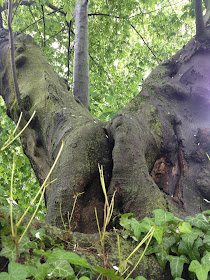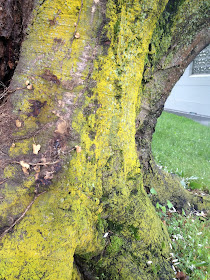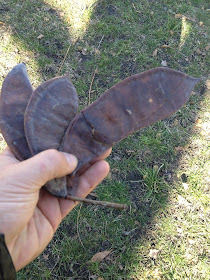I
grew up in this house.
This
isn’t a particularly original thought but, boy, it sure looks a lot smaller
than I remember.
It
just seems too small to house all those memories, all those holidays, all those
meals, all those toys and all those birthdays…and it doesn’t look big enough to
contain the big family that used to call it home…one happy couple, one beatnik
sister and five rambunctious boys, including one future champion tree-hunter.
It’s
also missing some trees.
There
used to be larger roses and more evergreen shrubs guarding the walkway to the front
door. There used to be a dwarf pear tree
and a rose of sharon on the driveway side of the house.
On
the other side of the house, there used to be a sour cherry tree.
At
the end of long summer days, I would cool down under the sour cherry tree with the
Lippincott brothers and we would throw our pits over the fence into the
neighbor’s in-ground pool, sorry about that.
I
found an old photo of the house and that’s when I remembered another tree, now
missing…
…that
tall Norway spruce rubbing up against the side of my childhood home.
These
are the trees of my past…the trees of yore…the phantom trees that can no longer
be found except in old photographs and fading memories…happy Memorial Day,
citybillies.
Contrary
to popular belief, trees do go missing.
I wish they wouldn’t move around so much but they do. They come and then they go.
Philadelphia,
too, is haunted by its own host of missing trees, none more famous than
the Great Elm of Shackamaxon.
THE PENN TREATY
Shackamaxon
was the name of the Lenape village located right here along the Delaware River
within the borders of the Philadelphia charter, in the neighborhoods currently
called Port Richmond and Fishtown.
According
to a few histories, Shackamaxon was the capital of the Lenape nation and the
seat of power for the chief of the Turtle Clan.
In
the village of Shackamaxon, there was a great elm.
In 1682, under the shadow of this great elm, William Penn made official peace with the chief of the Turtle Clan, a meeting that is known as the Treaty of Amity and Friendship.
There
is no record of the treaty, although William Penn himself once described the
scene in a letter, writing:
The king sits in
the middle of a half moon, and has his council, the old and wise on each
hand. Behind them or at little distance
sit the younger fry in the same figure.
Great promises
passed between us of kindness and good neighborhood, and that the English and
Indians must live in love as long as the sun gave light.
We will transmit
this League between us to our children.
It shall be made stronger and stronger, and be kept bright and clean
without rust or spot…
The
Treaty was sealed with the exchange of wampum belts.
The
elm tree, already tall and mighty during this historical handshake, finally
succumbed to heavy winds 128 years later, on March 3, 1810.
At
the time of its toppling, it was 283 years old, eight feet in diameter and
twenty-four feet in circumference.
Its
final height is in dispute but, if it was still alive, and even if it hadn’t
grown an inch since 1810, it would stand above us all, today, as the reigning
champion elm tree of Philadelphia.
Its
place is commemorated with a statue of brother William Penn himself, right off
Delaware Avenue, in Penn Treaty Park.
Philadelphia’s
most famous phantom tree, long gone but not forgotten, paid respect on the Friday
before Memorial Day 2013 by humble old Jon Spruce.
It
was a blustery, rainy day, smack dab in the middle of a busy holiday
weekend. My time was limited. Work was breathing down my neck and, by Jove,
it was almost June.
I
had very little free time. I hate using
that phrase. I wonder how you say free time in the Lenape language.
Time
wasn’t slipping by. That would imply I
still had a chance to grab it. Face
facts, Jon Spruce. Time was gone.
But if
I used my remaining time wisely, I could still find some new trees so, in the
spirit of Memorial Day, I drove west from Penn Treaty Park, up Spring Garden
Street. I swung around the Art Museum down
Kelly Drive and took the turn that led to the entrance of the Laurel Hill
Cemetery.
THE CEMETERY ON
THE HILL
Like
most tree-hunters, I love a good cemetery.
This
one, the Laurel Hill Historic Cemetery? This is a good one.
It’s
located on the top of the rocky bluffs that soar above the hairpin curves of
Kelly Drive overlooking the muddy Schuylkill River.
It
was the first cemetery to be designated as a National Historic Landmark and, if
you enjoy visiting famous graves, then this is a good place to go hunting.
Harry
Kalas is buried here. So is Owen Wister,
one of the pioneers of western fiction. Witmer
Stone is also buried here, the very first botanist to tackle the flora of the
New Jersey Pine Barrens.
Generals,
commodores, composers, explorers, Philadelphia mayors, Continental Congressmen,
signers of the Declaration of Independence, all buried here. David Rittenhouse is buried here too. He was responsible for the first American
telescope and the first American to find Uranus.
What’s the most famous grave here in Laurel Hill? Well, that’s a funny story.
What’s the most famous grave here in Laurel Hill? Well, that’s a funny story.
It
turns out the most famous person buried here never even existed in the real
world.
This
is also a good place to go tombstone reading.
As
a fan of literature, there is a part of me that enjoys a well-worded epitaph. A good tombstone can contain a superior level
of simple, frank poetry.
Etched
into stone, an ordinary turn of phrase has the chance to reach high craft.
Like this tribute, a lament to the young wife
Sarah Ann…
…who
just fell asleep one Sunday in May,
163 years ago.
Perhaps
the most interesting tombstone is this one…
…shared
by Professor Levy Franklin Smith and his devoted wife and spiritualist, Miss
Catharine Drinkhouse who, according to her epitaph…
…was
one of the best mediums of her time.
One
of the facets of this gravestone is dedicated to the code of the Masons…
…we meet upon the level, and we part upon the
square.
I like that.
Now I make it a general rule not to go messing around with the Masons but I sincerely hope that they all enjoyed
Miss Drinkhouse’s company for more than just her clairvoyant powers to
communicate with the dead.
I
mean, c’mon. A medium in heaven? I can’t think a more worthless occupation.
Well,
maybe one.
I
suppose, up there, there isn’t much demand for a good gravedigger.
Tombstone
reading is fun, I admit, but I was here to find new trees and, in that respect,
Laurel Hill, again, does not disappoint.
“RICH IN RARE
TREES…”
Laurel
Hill was always meant to be more than just a cemetery. John Jay Smith, the site’s first planner,
wanted the place to be a showcase for architecture, landscape gardening and
botany and he had over two thousand trees planted on the cemetery grounds.
Some
of the big trees here might've been planted by John Jay Smith himself, they look
so old and so worn, so established in their place.
I
found an old, old sycamore, with four incredible branches…
…and
one dinosaur of a spruce…
…flexing
its muscle over the grave of one Charles Hyneman and his wife Annie Chance.
The
roses were out and I found a gorgeous bramble of one…
…red,
rainy roses gracing the grave of Rebecca Clifford Fox.
The
heavy winds and the driving rain kept my head down but there was still lots to see on
the ground, including this year’s first tulip poplar flowers…
…and,
on the other side of the cemetery, I saw a typical phenomenon for this time of
year…
…a
black road awash in golden pollen.
This
normally means that there is a healthy, fertile honey locust nearby and, sure
enough, I found it.
These
are the flowers of the honey locust.
In
the fall, the tree will produce those large, dark, twisted bean pods. Somewhere still undiscovered by me, there is a
pathway between these delicate flowers and those thick bean pods.
I
suppose I could find that path but, in order for my feeble mind to understand,
I would have to take a picture of its transformation every day. That’s the only way I could follow that
route.
As
promised, the cemetery is rich in rare trees, especially the yellowwood.
The
yellowwood has a very small and limited native range, found only on the
rocky, limestone cliffs found in certain parts of Kentucky, North Carolina and
Tennessee. It is rare even there.
But
there are many yellowwoods here at Laurel Hill. The most impressive one stands near one of the
stone entrances…
…and
is a good example of its distinct habit of branching too close to the ground.
The
yellowwood is known in spring for its beautiful drapery of small white flowers…
…and
it’s known year-round for its distinctive smooth, gray bark…
…which,
for some reason, attracts a universe of moss and lichens.
Another
rare tree stands tall and proud over the grave of Caleb Horne, his wife Anna
Mary and their daughter, Phoebe.
That’s
the Kentucky coffeetree.
Its
flowers were out too…
…large
bushels of small flowers that, like the honey locust, will eventually transform
into a thick, brown bean pod.
I
found some on the ground, leftovers from last winter.
The
green, mushy pulp found in the pod is poisonous…
…although
those beans can be roasted and ground to make something that kind of tastes
like coffee, a trick used by the Native Americans and the origin of the tree’s
name.
This
is a good place to go tree-hunting but eventually the scenery will dampen the
adventurous soul. The rain wasn’t
helping. Even with a dauntless and
intrepid spirit, the cemetery’s population has a way of catching up with you.
“DEATH WILL
COME, ALWAYS OUT OF SEASON…”
An
unsettling sense of the morbid and the macabre began to cloud my heart and
rattle my walking bones.
A
quote from Carl Jung emerged from somewhere deep in my subconscious: What I have to tell about the hereafter, and
about life after death, consists entirely of memories…
What
a strange thing to say.
And
what, in his mind, was the difference between life after death and the hereafter. As someone who is obsessed with the notion of
here, I was suddenly struck by the
odd and sinister implications of that combination of words, hereafter.
The Lenape might’ve understood what he was talking about.
They
buried their dead in a fetal position.
And,
like most religions, the Turtle Islanders believed that there was a passageway
from this world to the next, but they didn’t imagine that passage as a sunny
tunnel or as a light ascension towards cloudier climes.
They
didn’t believe in some simple, quick flight up to heaven.
They
imagined it as another leg of life, a long journey, fraught with danger and
teeming with enemies.
For them, it will be high adventure.
It
will begin at the spot where you were buried.
After
collecting the totems that were buried in your grave, you will walk a path
through a cascading landscape of ditches, ravines and gulches.
The
sky will be both night and day.
The
sun will burn bright and hot, the moon will do the same. The constellations will be unfamiliar. Shadows of giant birds will cross your path
as you scramble over the high cliffs and walk along the red ridges.
At
the end of this landscape, you will come across an impossible canyon, a roaring
river miles below. A rickety rope bridge
will be the only way to cross the canyon but, half-way across, the river will
rise and try to destroy the bridge. Its
waves will break the ropes, splinter the boards and yap at your feet.
Making
it to the other side, you turn around. That’s
when you notice that it’s not a river.
It’s
a giant snake.
You'll continue down the path.
You will have to wend your way through a tight tangle of willow, hazel and
thorny rose.
The
woods will be thick with rabid frogs, slimy worms, bloodthirsty deer, angry
bears and evil birds whose songs tempt you into turning around and giving up.
When
you’ve finally cleared the woods, you will have to pass through a land burning
with fire.
The
whole time, you’ll have the feeling that you’re being followed.
Along
the path, there will be food. In most
legends, it will be fields of ode-e-min, which translates to heart-berry.
We
know it as the strawberry.
They
will be as big as boulders and some will be poisonous. Only those who paid attention to the
teachings of their elders will be able to tell the difference.
Finally,
you will come to the land of spirits.
You
will climb a ladder and you will find a long lodge with walls made of whaleskin
stitched together with deer antlers, fragrant smoke pumping out of the many cedar-wood
chimneys.
There,
you will meet the Mother of the Mountain.
She
assures you that all the trials are done, all the tribulations passed. She promises that you are home and, at first
glance, you agree.
This
place? It looks exactly like the world
you’ve left behind.
She
will feed you salmon and dried bear-ribs, acorn pancakes, sweet potatoes, corn,
berries and coffee.
After
the meal, you’ll continue up the ladder to stand in the presence of the
Earthmaker.
You’ll
receive two choices.
You
can stay in the Afterworld, in a place identical to your original village and
peopled with the entire lineage of your tribal tree.
Or
you can be born again to this world, the real world, for one more wild ride.
And
this is the part of the myth where I always lose my footing.
These
two choices have always befuddled me.
Both
worlds, at first glance, seem to be the same.
Same animals, same landscapes, same food, same trees, same tobacco. Mountains, rivers, woods, canyons, lakes,
stars, sun and moon? All the same.
In
the end, same people too. Even the
people you’ve left behind on the real world will, ultimately, catch up with you
in this spirit village.
But,
if you think about it, there are two stark differences.
This
will be the deciding factor in your choice.
In
one world, you will have to face death again, and again.
In
the other world, there will be no cemeteries.












































So many wonderful photographs. I haven't seen a yellowwood or coffee tree in a long time.
ReplyDeleteDear Sir,
ReplyDeleteYou illegally took one of the pictures from my website and inserted on yours. My website very clearly specify that all materials including any and all photos a copyrighted and you’ll need a permission to use them.
Ether you remove my picture immediately or give a credit including “live” link to the source. If not complied other actions will be taken.
My regards,
FishtownOnLine.com
PS: Here’s a link to the picture you took from my site.: http://www.fishtownonline.com/william-penn-indians.html
What a neat story - I have been to Fishtown but had not seen the William Penn statue, nor did I know the story of the great elm. Thanks for narrating all this.
ReplyDeleteSo glad you liked the story! The history of Philadelphia is full of trees.
ReplyDelete